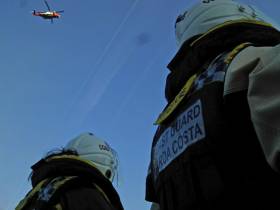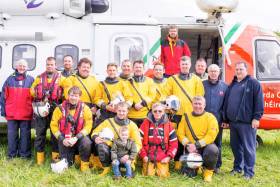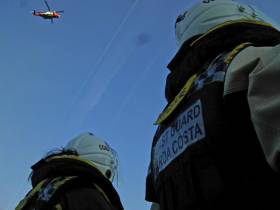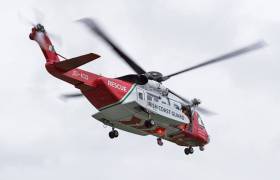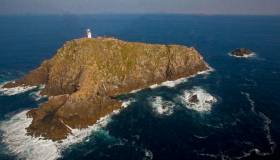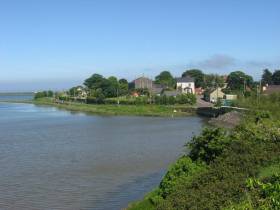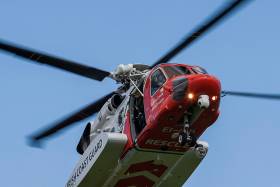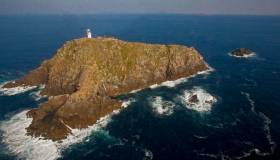Displaying items by tag: Irish Coast Guard
#Rescue - A tanker crewman was airlifted to hospital from the Port of Cork yesterday evening (Saturday 17 June) after sustaining a leg injury on board his vessel, as the Irish Examiner reports.
The Waterford-based Irish Coast Guard helicopter Rescue 117 was dispatched for the medevac of the casualty, who is thought to have broken his leg after a cable or rope snapped, after the local fire service was unable to remove him safely.
The Irish Examiner has much more on the story HERE.
#RNLI - Volunteers from Lough Ree RNLI had a successful training exercise with the Sligo-based Irish Coast Guard helicopter Rescue 118 yesterday (Sunday 11 June).
The lifeboat and helicopter crews came together for a joint training exercise at Lough Ree Yacht Club amid changeable weather conditions, with winds Force 4-6 and frequent rain showers blowing through.
On arrival, Rescue 118 landed at the yacht club grounds where the pilot and crew briefed the Lough Ree RNLI volunteers, after which they invited the RNLI crew, family members and yacht club members to have a tour of the helicopter.
The exercise got underway with the lifeboat crew members being winched between their inshore lifeboat The Eric Rowse and the helicopter. The strong winds enabled easier hovering for the helicopter, and provided the lifeboat crew with an invaluable experience.
Speaking following the exercise, Lough Ree RNLI volunteer deputy press officer Sarah Bradbury said: “Joint training exercises such as today’s allows our crews to develop their skills, work with and share learning experiences with our colleagues in the Irish Coast Guard and most importantly prepare for working effectively with each other when the time comes and we need to help someone in need.”
The exercise came days after a busy bank holiday weekend for the Lough Ree lifeboat, as previously reported on Afloat.ie.
#WaterSafety - The Irish Coast Guard and the RNLI have issued a joint call urging people to be vigilant and take care in and on the water or along the coastline this June Bank Holiday weekend and over the summer holidays.
Both organisations have launched safety campaigns to highlight the potential dangers of the water.
The coastguard is promoting a new message this summer asking people to Stay Afloat – Stay in Contact, which aims to underpin the concept that if you are wearing a lifejacket or floatation device and can raise the alarm then you stand an excellent chance of being rescued.
Meanwhile, the RNLI’s drowning prevention campaign Respect the Water is asking people to fight their instincts and not the water to stay alive.
The advice comes as new research commissioned by the charity has revealed that 39% of Irish people questioned said they would follow their instincts and fight against the water, if they unexpectedly fell into it.
However, the RNLI is asking people to fight these instincts and remember one simple piece of advice – floating – that could save lives from drowning.
The public are also being reminded to avoid unnecessary risks when walking on cliffs and exposed coastlines by keeping to recognised routes and keeping dogs on a lead at all times.
Both organisations have emphasised the importance of not only wearing a lifejacket but also ensuring that it is regularly serviced.
Speaking ahead of the Bank Holiday weekend, Irish Coast Guard operations manager Gerard O’Flynn said: “This is an exciting time of the year to get out and enjoy the coast and the sea. We want people to enjoy the water but ask that you please adhere to your personal safety.
“Always respect the water and if you plan to go to sea ensure that if you are unfortunate to fall in that you can manage to stay afloat and raise the alarm.”
RNLI lifesaving delivery manager Gareth Morrison added: “The RNLI’s volunteer lifeboat crews launch to hundreds of calls for help every year in Ireland but sadly, not everyone can be reached in time.
“If you find yourself in danger in the water, you can help yourself by floating and regaining control of your breathing.
“We want people to enjoy their day out this summer without having to call the rescue services and you can do this by following some simple safety advice. For those planning to go into the water, the best way to stay safe is to choose a lifeguarded beach and swim between the flags.
“We would remind everyone to always wear a lifejacket and, importantly, ensure it is fully serviced as you are risking your life if it is not in working order.”
Morrison added: “Over the summer months the RNLI’s community safety team will be hosting a number of free lifejacket advice clinics and we would encourage all owners to avail of the opportunity to check their lifejacket is safe to use.”
Remember if you do get into trouble or see someone in difficulty, call the Irish Coast Guard on VHF Channel 6 or dial 112 and ask for the coastguard.
#Coastguard - The Irish Coast Guard has airlifted a sailor with leg injuries from a Royal Navy submarine off the West Coast of Ireland, as The Irish Times reports.
Sligo’s Rescue 118 helicopter was dispatched to the scene some 277km west of Achill Island yesterday morning (Tuesday 9 May), with top cover provided by the Shannon-based Rescue 115.
The submarine crewman was flown to Sligo University Hospital for treatment.
An earier version of this story erroneously reported the submarine crewman as Irish but his nationality is uncomfirmed.
#Coastguard - Late last night (Sunday 30 April) the Irish Coast Guard’s Shannon-based helicopter Rescue 115 was involved in a medevac mission from Tralee to Dublin.
The coastguard crew collected the patient from University Hospital Kerry and flew them to Dublin Airport for onward transfer.
This latest air ambulance mission came a week after a nine-month-old girl, her mother and a medical team were airlifted across the Irish Sea for an urgent transplant operation.
Rescue 117 from Waterford flew to the aid of little Sophie Bell and her mother Sarah on Friday 21 April as they needed to be at King’s College Hospital in London for a vital liver transplant, as the Irish Post reports.
The coastguard also offered to return mother and baby to Ireland at the end of last week as Sophie continues to wait for a new liver, said Sarah.
#Rescue116 - More than 100 divers have joined a major search since early this morning (Saturday 22 April) for Paul Ormsby and Ciaran Smith, the two Irish Coast Guard crew members still missing after the Rescue 116 tragedy over a month ago.
According to The Irish Times, an exclusion zone around the wreck site at Black Rock off Co Mayo has been lifted for the search, thought to be the largest ever co-ordinated dive in the history of the State.
Naval Service and Garda divers are joined by specialists in sub-sea search and recovery in combing the sea bed of at the western and south-western parts of the island, following the completion of a ‘360-degree’ terrain survey by the Army and Garda crime scene examiners.
The Irish Times has much more on the story HERE.
Boyne Boat Capsize Trio ‘Lucky To Be Alive’
#Coastguard - Three people are “extremely lucky to be alive” after their boat upturned on the River Boyne last night (Monday 17 April), as TheJournal.ie reports.
The three casualties rescued east of Mornington, Co Meath were found to be not wearing lifejackets when they were rescued by volunteers from Drogheda Coast Guard.
Clogherhead RNLI also attended the incident, which occurred east of Drogheda Port, after a member of the public raised the alarm around 9.30pm.
“Only for the quick thinking of the caller and the rapid response from all agencies involved were we able to bring this incident to a successful conclusion,” said an Irish Coast Guard statement.
Elsewhere, DublinLive reports on Howth Coast Guard’s rescue of two kayakers stranded at Ireland’s Eye on Saturday afternoon (15 April).
The coastguard volunteers were on exercise when by chance they happened upon the kayaking duo, who had set out with no means to call for help.
“We’re Gone”: Final Moments Of Rescue 116 Show Helicopter ‘Pitched Up Rapidly’ Before Crash
#Rescue116 - The interim report from the investigation into the Rescue 116 tragedy has found that the Irish Coast Guard helicopter “pitched up rapidly” in its final seconds before crashing off Co Mayo a month ago.
Data recovered from the Sikorsky S-92’s ‘black box’ paints a terrifying picture of the seconds before the coastguard helicopter was lost at Black Rock in the early hours of Tuesday 14 March, with one of the crew calling for evasive action as the island loomed dead ahead.
Moreover, details in the Air Accident Investigation Unit’s (AAIU) preliminary report suggest the aircraft was flying using a pre-programmed route that was missing specific data relating to Black Rock, a small island east of Blacksod on the Mullet Peninsula.
Recordings from the cockpit also reveal that neither the mission commander and pilot Capt Dara Fitzpatrick nor co-pilot Capt Mark Duffy, whose lives were lost in the incident, had recent familiarity with landing in the area.
The Dublin-based coastguard SAR helicopter had been dispatched late on Monday 13 March to provide top cover for an offshore medevac being attended by Sligo’s Rescue 118.
Contact was lost with Rescue 116 as it approached Blacksod for refuelling and a search began immediately, with wreckage soon spotted off the western end of Black Rock and Capt Fitzpatrick recovered from the water within hours of the crash, though she later died in hospital.
Capt Duffy’s remains were recovered from the cockpit on the sea bed more than a week later. The search continues for their crew mates, winch men Ciarán Smith and Paul Ormsby, though after a major sweep by more than 100 fishing vessels this last weekend, the operation is now being wound down.
Rescue 116’s dual flight data recorder and cockpit voice recorder was recovered from the sea bed on Friday 24 March. Examination of the hardware revealed water damage to its memory board, requiring delicate desoldering of its circuits to recover the data, a process that is ongoing at the AAIB laboratory in the UK.
Additional data recovered from the aircraft’s Health and Usage Monitoring System (HUMS) identified no diagnostic alerts regarding Rescue 116’s critical systems or components.
Position data from the HUMS card was used to generate a placemark for what appears to be the last recorded position of the aircraft, though in its final seconds it was “subjected to complicated flight dynamics and a progressive deterioration of structural and systems integrity”.
All available data adds up to the following picture of the situation inside Rescue 116 before its loss:
- The mission commander and pilot (Capt Dara Fitzpatrick) was seated right of the co-pilot (Capt Mark Duffy) in the cockpit.
- All crew communications were mission-focused with no outside distractions.
- The helicopter routed from Dublin towards Sligo, then adjusted heading based on fuel requirements to Blacksod Lighthouse before a planned routing to the SAR mission offshore.
- After a crew briefing prior to arrival at Blacksod, Capt Fitzpatrick remarked that it has been some time since she had landed at Blacksod; Capt Duffy later said he had also not been to the area recently.
- The cockpit voice recording contains no reference by the crew to the presence of a lighthouse or terrain at Black Rock.
- The recording also indicates that Capt Duffy was using the helicopter’s weather radar to identify terrain features.
- 26 seconds before impact, the radio altitude sensor gave an aural alert, which Capt Fitzpatrick explained as “just a small little island... that’s B L M O [referring to Black Rock] itself”. Data places the aircraft at this time near an outcrop of two rocks just over half a nautical mile west of Black Rock.
- 13 seconds before impact, one of the rear crew members identified an island “directly ahead of us now guys” and suggested the helicopter should “come right” by “20 degrees”.
- Data shows the heading change was made before the rear crewman added with urgency to “come right now come right COME RIGHT”. A second later, Capt Duffy said: “We’re gone.”
- Two seconds before initial impact, data shows the helicopter pitched nose up, then after impact climbed with large changes in pitch, roll and yaw.
The recorded data, while not definitive, indicates that the flight crew was using an operator-specific route guide — a review of which is now warranted, says the AAIU.
The report also includes a recommendation to review instructions for the use of locator beacons on the Mk 44 lifejackets used by the crew, two of whom remain missing four weeks after the incident.
The AAIU investigation continues, but the preliminary report is available in full as a PDF to download below.
Update 15 April 2017: This article was changed to correct a misattribution of the final quote by Capt Mark Duffy to his colleague Capt Dara Fitzpatrick. The original article also misstated the designation of the pilot (and mission commander) and co-pilot.
Body Recovered After Cliffs Of Moher Fall Tragedy
#CliffsOfMoher - The body of what’s believed to be a young German man has been recovered from the Clare coast hours after he was seen falling from the Cliffs of Moher, as BreakingNews.ie reports.
Passers-by north of O’Brien’s Tower raised the alarm around 6.30pm on Saturday evening (8 April) but fading light and poor sea conditions delayed recovery by Irish Coast Guard volunteers till yesterday afternoon (Sunday 9 April).
#Rescue116 - The Coast Guard Rescue Coordination Centre in Malin will tomorrow (Saturday 8 April) assist with managing the surface search for the two missing crewmen of Rescue 116 by a large number of fishing vessels that have offered their services.
No trace of Paul Ormsby or Ciarán Smith was found when the wreck of the Sikorsky S-92 helicopter was lifted from the sea bed off Black Rock in Co Mayo last weekend, as previously reported on Afloat.ie.
While underwater operations are ongoing, a fleet of fishing vessels from Killybegs this week pledged to sweep the Atlantic seaboard from first light tomorrow for any sign of the missing coastguard airmen, according to The Irish Times.
The South Donegal and North Mayo coast has been divided into a number of search areas, each under the direction of an RNLI or Irish Coast Guard asset. The Naval Service ship LÉ Ciara will be on scene ready to assist where required.
Meanwhile, the coastguard is requesting all mariners in the area to keep a good lookout for any debris in the course of their routine activities and to report any findings to the Malin Head Coast Guard Coordination Centre.
Coastguard officials expressed their ongoing appreciation to the many volunteers supporting the search, in particular coastguard members, lifeboat volunteers and Civil Defence, as well as local community support.
Update from the RNLI: Lifeboats from Ballyglass, Achill, Sligo, Bundoran and Arranmore, along with Killybegs and Killala Coast Guard, will be on scene for the day and will keep in communication with all vessels.
The RNLI wishes to join with the coastguard in stressing the importance of safety for every person taking part in the search. Each individual should be wearing a personal floatation device and have access to a working VHF for communications.
While engaged in the search, the RNLI lifeboats will remain on call and available for search and rescue operations. Should an RNLI lifeboat need to respond to an emergency elsewhere a designated deputy vessel will be appointed.
Commenting on the planned search, RNLI lifesaving manager Gareth Morrison said: “Since the loss of Rescue 116 our lifeboat crews from Ballyglass and Achill, later joined by Arranmore, Sligo and Bundoran have spent a huge number of hours out searching. This has been in conjunction with our colleagues in the Irish Coast Guard, Naval Service, Civil Defence and with local vessels.
“Most of our lifeboat crew are volunteers who have left families and jobs to engage in the search. I want to take this opportunity to thank all the RNLI lifeboat crews, station personnel and wider communities who have taken part.”
“With everyone involved in the search on Saturday staying vigilant and safe and following the directions from the on scene coordinators we will cover a huge area safely. We also ask that people continue to keep a lookout for any debris and report findings to the coastguard.”
Morrison concluded: “Our thoughts remain with the families and colleagues of the crew of Rescue 116.”


























